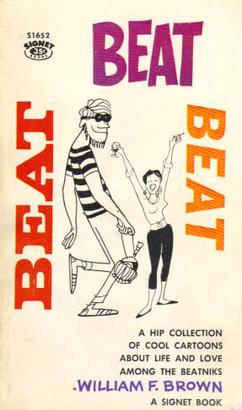Beatnik
Beatnik was a media stereotype prevalent throughout the 1950s to mid-1960s that displayed the more superficial aspects of the Beat Generation literary movement of the 1950s. Elements of the beatnik trope included pseudo-intellectualism, drug use, and a cartoonish depiction of real-life people along with a range of stereotypical attributes such as wearing striped shirts and berets, playing bongos, and living a bohemian lifestyle. The beatnik image has become an enduring representation of the era, though it often oversimplified and commercialized the underlying social and literary movements it sought to represent.
Origins and History[edit | edit source]
The term "beatnik" was coined by San Francisco Chronicle columnist Herb Caen in 1958 by combining the name of the recent Russian satellite Sputnik with "beat," referring to the beat generation. The beat generation, including figures such as Jack Kerouac, Allen Ginsberg, and William S. Burroughs, was characterized by its rejection of standard narrative values, the exploration of religion, sexuality, and drugs, and an interest in Eastern spirituality. The beatnik image, however, focused more on the superficial aspects of this lifestyle rather than its literary and philosophical underpinnings.
Characteristics[edit | edit source]
Beatniks were often portrayed as wearing black turtlenecks, berets, and glasses, with goatees for men, and living in Greenwich Village, New York, or North Beach, San Francisco. They were depicted as being idle, speaking in a slang that combined complex jargon and philosophical terms, and participating in poetry readings and jazz performances. This caricature served to both popularize and trivialize the genuine artistic and social movements of the time.
Cultural Impact[edit | edit source]
The beatnik stereotype played a significant role in the popular culture of the 1950s and 1960s, appearing in movies, television shows, and comic strips. It both reflected and influenced public perceptions of the beat generation, contributing to a widespread fascination with a bohemian lifestyle. Over time, the beatnik image evolved into the hippie movement of the 1960s, which shared some of the beat generation's ideals but also differed significantly in terms of political activism and cultural expressions.
Criticism and Legacy[edit | edit source]
The beatnik image has been criticized for its reduction of a complex literary and social movement to a set of superficial traits. Critics argue that this stereotype overshadowed the serious literary contributions of beat writers and simplified their nuanced exploration of society. Despite this, the beatnik image remains an iconic representation of mid-20th-century American culture, embodying the era's tensions between conformity and the desire for freedom and authenticity.
See Also[edit | edit source]
Navigation: Wellness - Encyclopedia - Health topics - Disease Index - Drugs - World Directory - Gray's Anatomy - Keto diet - Recipes
Search WikiMD
Ad.Tired of being Overweight? Try W8MD's physician weight loss program.
Semaglutide (Ozempic / Wegovy and Tirzepatide (Mounjaro) available.
Advertise on WikiMD
WikiMD is not a substitute for professional medical advice. See full disclaimer.
Credits:Most images are courtesy of Wikimedia commons, and templates Wikipedia, licensed under CC BY SA or similar.
Contributors: Prab R. Tumpati, MD





